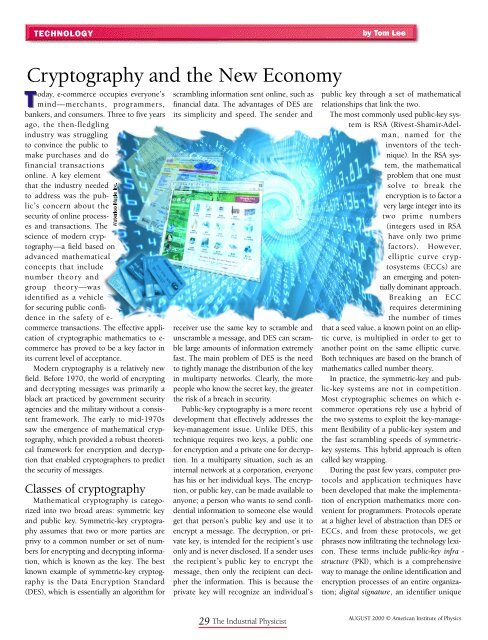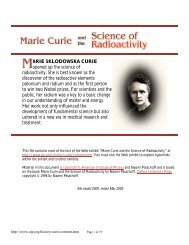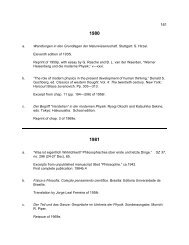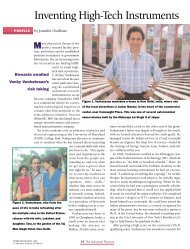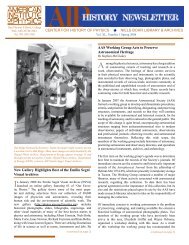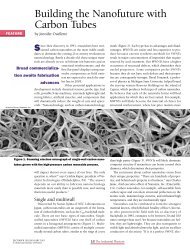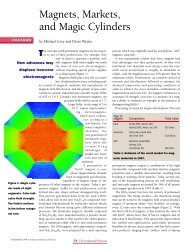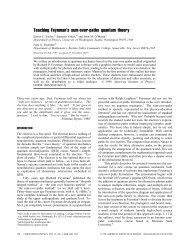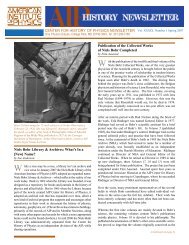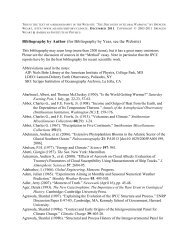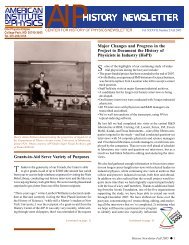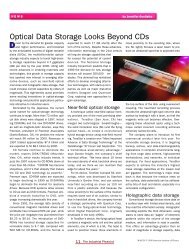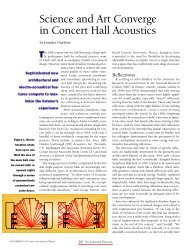Cryptography and the New Economy - American Institute of Physics
Cryptography and the New Economy - American Institute of Physics
Cryptography and the New Economy - American Institute of Physics
Create successful ePaper yourself
Turn your PDF publications into a flip-book with our unique Google optimized e-Paper software.
T E C H N O L O G Y by Tom Lee<br />
<strong>Cryptography</strong> <strong>and</strong> <strong>the</strong> <strong>New</strong> <strong>Economy</strong><br />
o d a y, e-commerce occupies every o n e ’ s<br />
mind—merchants, programmers,<br />
bankers, <strong>and</strong> consumers. Three to five years<br />
ago, <strong>the</strong> <strong>the</strong>n-fledgling<br />
i n d u s t ry was struggling<br />
to convince <strong>the</strong> public to<br />
m a ke purchases <strong>and</strong> do<br />
financial transactions<br />
online. A key element<br />
that <strong>the</strong> industry needed<br />
to address was <strong>the</strong> public’s<br />
concern about <strong>the</strong><br />
security <strong>of</strong> online processes<br />
<strong>and</strong> transactions. The<br />
science <strong>of</strong> modern cry ptography—a<br />
field based on<br />
advanced ma<strong>the</strong>matical<br />
concepts that include<br />
number <strong>the</strong>ory <strong>and</strong><br />
group <strong>the</strong>or y — w a s<br />
identified as a vehicle<br />
for securing public confidence<br />
in <strong>the</strong> safety <strong>of</strong> ecommerce<br />
transactions. The effective application<br />
<strong>of</strong> cryptographic ma<strong>the</strong>matics to ecommerce<br />
has proved to be a key factor in<br />
its current level <strong>of</strong> acceptance.<br />
Modern cryptography is a relatively new<br />
field. Before 1970, <strong>the</strong> world <strong>of</strong> encrypting<br />
<strong>and</strong> decrypting messages was primarily a<br />
black art practiced by government security<br />
agencies <strong>and</strong> <strong>the</strong> military without a consistent<br />
framework. The early to mid-1970s<br />
saw <strong>the</strong> emergence <strong>of</strong> ma<strong>the</strong>matical cry ptography,<br />
which provided a robust <strong>the</strong>oretical<br />
framework for encryption <strong>and</strong> decry ption<br />
that enabled cryptographers to predict<br />
<strong>the</strong> security <strong>of</strong> messages.<br />
Classes <strong>of</strong> cryptography<br />
Ma<strong>the</strong>matical cryptography is categorized<br />
into two broad areas: symmetric key<br />
<strong>and</strong> public ke y. Symmetric-key cry p t o g r aphy<br />
assumes that two or more parties are<br />
privy to a common number or set <strong>of</strong> numbers<br />
for encrypting <strong>and</strong> decrypting information,<br />
which is known as <strong>the</strong> key. The best<br />
known example <strong>of</strong> symmetric-key cryptography<br />
is <strong>the</strong> Data Encr yption St<strong>and</strong>ard<br />
(DES), which is essentially an algorithm for<br />
scrambling information sent online, such as<br />
financial data. The advantages <strong>of</strong> DES are<br />
its simplicity <strong>and</strong> speed. The sender <strong>and</strong><br />
receiver use <strong>the</strong> same key to scramble <strong>and</strong><br />
unscramble a message, <strong>and</strong> DES can scramble<br />
large amounts <strong>of</strong> information extremely<br />
fast. The main problem <strong>of</strong> DES is <strong>the</strong> need<br />
to tightly manage <strong>the</strong> distribution <strong>of</strong> <strong>the</strong> key<br />
in multiparty networks. Clearly, <strong>the</strong> more<br />
people who know <strong>the</strong> secret key, <strong>the</strong> greater<br />
<strong>the</strong> risk <strong>of</strong> a breach in security.<br />
Public-key cryptography is a more recent<br />
development that effectively addresses <strong>the</strong><br />
ke y-management issue. Unlike DES, this<br />
technique requires two keys, a public one<br />
for encryption <strong>and</strong> a private one for decryption.<br />
In a multiparty situation, such as an<br />
internal network at a corporation, everyone<br />
has his or her individual keys. The encryption,<br />
or public key, can be made available to<br />
anyone; a person who wants to send confidential<br />
information to someone else would<br />
get that person’s public key <strong>and</strong> use it to<br />
encrypt a message. The decryption, or private<br />
key, is intended for <strong>the</strong> recipient’s use<br />
only <strong>and</strong> is never disclosed. If a sender uses<br />
<strong>the</strong> recipient’s public key to encrypt <strong>the</strong><br />
message, <strong>the</strong>n only <strong>the</strong> recipient can decipher<br />
<strong>the</strong> information. This is because <strong>the</strong><br />
private key will recognize an individual’s<br />
29 The Industrial Physicist<br />
public key through a set <strong>of</strong> ma<strong>the</strong>matical<br />
relationships that link <strong>the</strong> two.<br />
The most commonly used public-key system<br />
is RSA (Rivest-Shamir-Ad e lman,<br />
named for <strong>the</strong><br />
inventors <strong>of</strong> <strong>the</strong> technique).<br />
In <strong>the</strong> RSA system,<br />
<strong>the</strong> ma<strong>the</strong>matical<br />
problem that one must<br />
solve to break <strong>the</strong><br />
e n c ryption is to factor a<br />
v e ry large integer into its<br />
two prime numbers<br />
(integers used in RSA<br />
have only two prime<br />
factors). However,<br />
elliptic curve cry ptosystems<br />
(ECCs) are<br />
an emerging <strong>and</strong> potentially<br />
dominant approach.<br />
Breaking an ECC<br />
requires determining<br />
<strong>the</strong> number <strong>of</strong> times<br />
that a seed value, a known point on an elliptic<br />
curve, is multiplied in order to get to<br />
ano<strong>the</strong>r point on <strong>the</strong> same elliptic curve.<br />
Both techniques are based on <strong>the</strong> branch <strong>of</strong><br />
ma<strong>the</strong>matics called number <strong>the</strong>ory.<br />
In practice, <strong>the</strong> symmetric-key <strong>and</strong> publ<br />
i c - key systems are not in competition.<br />
Most cryptographic schemes on which ecommerce<br />
operations rely use a hybrid <strong>of</strong><br />
<strong>the</strong> two systems to exploit <strong>the</strong> key-management<br />
flexibility <strong>of</strong> a public-key system <strong>and</strong><br />
<strong>the</strong> fast scrambling speeds <strong>of</strong> symmetrickey<br />
systems. This hybrid approach is <strong>of</strong>ten<br />
called key wrapping.<br />
During <strong>the</strong> past few years, computer protocols<br />
<strong>and</strong> application techniques have<br />
been developed that make <strong>the</strong> implementation<br />
<strong>of</strong> encryption ma<strong>the</strong>matics more convenient<br />
for programmers. Protocols operate<br />
at a higher level <strong>of</strong> abstraction than DES or<br />
ECCs, <strong>and</strong> from <strong>the</strong>se protocols, we get<br />
phrases now infiltrating <strong>the</strong> technology lexicon.<br />
These terms include p u b l i c - key infra -<br />
s t r u c t u r e (PKI), which is a comprehensive<br />
way to manage <strong>the</strong> online identification <strong>and</strong><br />
encryption processes <strong>of</strong> an entire organization;<br />
digital signature, an identifier unique<br />
AUGUST 2000 © <strong>American</strong> <strong>Institute</strong> <strong>of</strong> <strong>Physics</strong>
Te c h n o l o gy<br />
to an individual; <strong>and</strong> certificate authority<br />
(CA), which is <strong>the</strong> industry-established system<br />
that certifies to buyers that an online<br />
business is legitimate.<br />
Until a few years ago, modern cry p t o g r aphy<br />
was <strong>the</strong> exclusive domain <strong>of</strong> pure ma<strong>the</strong>maticians<br />
working for universities, <strong>the</strong> milit<br />
a ry, <strong>and</strong> government agencies. When <strong>the</strong><br />
business world embraced encryption, we<br />
began hearing acronyms such as PKI <strong>and</strong> CA .<br />
In fact, cryptography has emerged as one <strong>of</strong><br />
<strong>the</strong> hottest areas in so-called enterprise computing.<br />
To d a y, some <strong>of</strong> <strong>the</strong> largest conferences<br />
in mainstream computing are on cry pt<br />
o g r a p h y. The RSA Conference, <strong>the</strong> Entrust<br />
SecureSummit Conference, <strong>and</strong> <strong>the</strong> Certicom<br />
Public Key Solutions Conference are ex a mples<br />
<strong>of</strong> annual events at which thous<strong>and</strong>s <strong>of</strong><br />
people ga<strong>the</strong>r to discuss cry p t o g r a p h y.<br />
Many number <strong>the</strong>orists once boasted<br />
that <strong>the</strong>y could see no possible way that <strong>the</strong><br />
purity <strong>and</strong> beauty <strong>of</strong> <strong>the</strong>ir research area<br />
could ever be tainted by military or com-<br />
mercial applications. Unfortunately for<br />
<strong>the</strong>m, <strong>the</strong> adoption <strong>of</strong> number <strong>the</strong>ory to<br />
c ryptography represents perhaps <strong>the</strong> most<br />
pr<strong>of</strong>ound integration <strong>of</strong> abstract <strong>the</strong>ory into<br />
everyday life in recent history.<br />
Everyday applications<br />
To appreciate <strong>the</strong> impact <strong>of</strong> cryptography<br />
on daily life, one needs to better underst<strong>and</strong><br />
some <strong>of</strong> its key commercial applications.<br />
Internet sales <strong>and</strong> mobile commerce<br />
are two prominent examples.<br />
Most reputable players in Web-based ecommerce<br />
share a common framework <strong>of</strong><br />
cryptographic protocols. Many use a protocol<br />
known as <strong>the</strong> Secure Socket Layer (SSL),<br />
which Netscape pioneered for e-commerce.<br />
This particular protocol has enabled many<br />
transactions to take place online, from <strong>the</strong><br />
simple purchasing <strong>of</strong> goods to banking <strong>and</strong><br />
bill paying. Through SSL, users can positively<br />
identify a Web site as being reputable<br />
<strong>and</strong> know that <strong>the</strong>y are sending confidential<br />
information, such as credit card numbers,<br />
through a secure, encrypted system.<br />
SSL is a variation <strong>of</strong> public-key encry ption.<br />
It uses RSA-based digital signatures,<br />
which are analogous to a personal signature,<br />
to identify online users. The s<strong>of</strong>tware for SSL<br />
is typically embedded in computer browsers<br />
<strong>and</strong> <strong>the</strong> server s<strong>of</strong>tware <strong>of</strong> e-commerce sites.<br />
Supporting <strong>the</strong> RSA routines is <strong>the</strong> DES<br />
s y m m e t r i c - e n c ryption scheme, which performs<br />
<strong>the</strong> actual encryption <strong>of</strong> credit-card<br />
numbers or o<strong>the</strong>r data. In most <strong>of</strong> <strong>the</strong><br />
world, <strong>the</strong> DES encryption strength is 56<br />
bits (<strong>the</strong> number <strong>of</strong> bits indicates <strong>the</strong> size <strong>of</strong><br />
<strong>the</strong> key; <strong>the</strong> more bits, <strong>the</strong> stronger <strong>the</strong><br />
e n c ryption power). However, <strong>the</strong> National<br />
<strong>Institute</strong> <strong>of</strong> St<strong>and</strong>ards <strong>and</strong> Technology will<br />
soon announce a new st<strong>and</strong>ard called <strong>the</strong><br />
Advanced Encryption St<strong>and</strong>ard, which has<br />
a strength <strong>of</strong> 128, 192, or 256 bits.<br />
A recent e-commerce phenomenon<br />
involves <strong>the</strong> convergence <strong>of</strong> Internet access<br />
with small <strong>and</strong> <strong>of</strong>ten wireless devices such
USING YOUR CREDIT CARD ON THE WEB<br />
If you want to buy a sweater on <strong>the</strong> We b , <strong>the</strong> personal details you enter on your computer <strong>and</strong> send to <strong>the</strong> merchant are encrypted with a key number<br />
that is virtually impossible for a hacker to find.<br />
SETTING UP SHOP. In a commonly used public key system called <strong>the</strong> RSA system, when a merchant sets up for e-commerce, two r<strong>and</strong>om large prime<br />
n u m b e rs ,p <strong>and</strong> q, are chosen, <strong>and</strong> <strong>the</strong> product p q = n is calculated. The product n is used to generate a public encryption key number, K e , <strong>and</strong> a private<br />
or secret decryption key number, K d . In <strong>the</strong> next stage, an industry - t rusted certificate authority endorses <strong>the</strong> merchant’s identity by taking K e <strong>and</strong> o<strong>the</strong>r<br />
merchant inform a t i o n ,<strong>and</strong> digitally “signing” it. Ma<strong>the</strong>matically, this step is roughly equivalent to raising <strong>the</strong> information to <strong>the</strong> power <strong>of</strong> <strong>the</strong> numerical<br />
value <strong>of</strong> K d . This creates a “certificate” for <strong>the</strong> merchant, which is <strong>the</strong> digital analog <strong>of</strong> <strong>of</strong>ficial identification papers. Every recognized,t rusted cert i f i c a t e<br />
authority has a collection <strong>of</strong> digital cert i f i c a t e s ,each one corresponding to a merchant. During a transaction, <strong>the</strong>se certificates may be sought via <strong>the</strong><br />
Web to positively identify a merchant.<br />
STARTING A TRANSACTION. When a customer begins <strong>the</strong> checkout process at a Web site,his or her computer automatically sends information<br />
about <strong>the</strong> browser to <strong>the</strong> merchant’s computer, which sends its certificate, signed by a certificate authority, to <strong>the</strong> customer. The certificate<br />
includes <strong>the</strong> merchant’s K e . The customer’s computer checks <strong>the</strong> merchant’s certificate <strong>and</strong> K e against his browser’s preloaded collection <strong>of</strong> cert i f icates<br />
from recognized <strong>and</strong> trusted cert i f i c a t e<br />
authorities. If <strong>the</strong> merchant’s part i c u l a rs check<br />
o u t ,<strong>the</strong> customer’s computer ma<strong>the</strong>matically<br />
e n c rypts its own identifying key inform a t i o n<br />
(n <strong>and</strong> K e ) with <strong>the</strong> merchant’s K e , a n d<br />
<strong>the</strong> customer generates a secret number,<br />
K s . This is sent back to <strong>the</strong> merchant’s<br />
c o m p u t e r, e n c rypted with <strong>the</strong> merc<br />
h a n t ’s n <strong>and</strong> K e . The merchant can<br />
d e c rypt <strong>the</strong> secret number using his<br />
K d . Both computers now share a common<br />
secret number, K s , that can be<br />
used as <strong>the</strong> master session key for <strong>the</strong><br />
s y m m e t r i c - e n c ryption step. A secure<br />
channel is established. All inform a t i o n<br />
( e . g. , <strong>the</strong> credit card number) is encry p t e d<br />
using this session key when entering <strong>the</strong><br />
channel <strong>and</strong> is decrypted when leaving <strong>the</strong><br />
channel. Once <strong>the</strong> transaction is completed,<br />
<strong>the</strong> session key is destroyed on both ends.<br />
WHY WE ARE SAFE. To break <strong>the</strong><br />
e n c ry p t i o n , a hacker would need to<br />
access <strong>the</strong> data channel at part i c u l a r<br />
steps <strong>of</strong> <strong>the</strong> process, u n d e rst<strong>and</strong> <strong>and</strong><br />
p e r f o rm <strong>the</strong> complex ma<strong>the</strong>matical backtracking<br />
to expose <strong>the</strong> product n = p q, f a ctor<br />
n, <strong>and</strong> <strong>the</strong>n derive <strong>the</strong> merchant key<br />
Kd , which would allow him to recov e r<br />
<strong>the</strong> session key <strong>and</strong> retrieve sensitive<br />
i n f o rmation. The problem for <strong>the</strong><br />
h a c ker is that <strong>the</strong> successful factoring<br />
<strong>of</strong> n is virtually impossible.<br />
Hacker<br />
A recent empirical test—<strong>the</strong> Cert icom<br />
Challenge (Hay wa r d , C a l i f o rn<br />
i a ) — s h o wed that cracking even a<br />
single test or simple encry p t i o n<br />
required performing hundreds <strong>of</strong> trillions<br />
<strong>of</strong> iterations <strong>of</strong> <strong>the</strong> ma<strong>the</strong>matics on 9,500 high-perfor-<br />
Customer<br />
List <strong>of</strong><br />
trusted<br />
certificate<br />
authorities<br />
Browser<br />
K ms<br />
Master sessionencryption<br />
key<br />
mance computers from 40 countries running in a coordinated fashion<br />
over four months. These test encryptions are considered 100 million<br />
times we a ker than commercial grade encryption. Thus, with today ’s technology<br />
<strong>and</strong> knowledge, <strong>the</strong>re are not enough accessible computers <strong>and</strong> personnel to manage<br />
efficient cracking <strong>of</strong> commercial-grade encryption. Howev e r, if unauthorized people get<br />
access to some <strong>of</strong> this inform a t i o n ,<strong>the</strong>re is a vulnerability.<br />
K e<br />
Merchant’s<br />
encryption key<br />
Merchant’s<br />
e-commerce<br />
server<br />
Digital<br />
certificate<br />
(includes K e )<br />
d<br />
Merchant’s<br />
decryption<br />
Merchant’s<br />
warehouse<br />
Sweater<br />
Certificate<br />
authority
Te c h n o l o gy<br />
as mobile phones, h<strong>and</strong>-held computers<br />
with modems, two-way pagers, <strong>and</strong> hybrids<br />
that embody two or more <strong>of</strong> <strong>the</strong>se technologies.<br />
Inexpensive, useful information services<br />
are now available to help people look<br />
up telephone numbers, buy <strong>and</strong> sell stocks,<br />
<strong>and</strong> carry out o<strong>the</strong>r time-critical tasks anywhere<br />
that is served by appropriate wireless<br />
services. In some respects, <strong>the</strong> need for<br />
c ryptographic security is even greater for<br />
<strong>the</strong>se uses because wireless channels are<br />
less secure than wired channels.<br />
Protocols based on ECC are becoming<br />
<strong>the</strong> st<strong>and</strong>ard for <strong>the</strong> information-au<strong>the</strong>nticating<br />
step for wireless devices. Functionall<br />
y, ECC is similar to <strong>the</strong> more established<br />
RSA system. However, commercial versions<br />
<strong>of</strong> ECC <strong>of</strong>fer key sizes that are an order <strong>of</strong><br />
magnitude smaller than an RSA <strong>of</strong> equivalent<br />
strength, <strong>and</strong> thus, <strong>the</strong>y provide shorter<br />
computation times for some operations.<br />
This greater efficiency is critical for b<strong>and</strong>width-limited<br />
<strong>and</strong> battery-operated devices.<br />
Certicom (Hayward, CA) is <strong>the</strong> commercial<br />
leader in ECC implementations, although<br />
o<strong>the</strong>r companies are beginning to <strong>of</strong>fer<br />
<strong>the</strong>ir own versions. Companies that have<br />
deployed ECC-based security in <strong>the</strong>ir products<br />
include 3Com’s Palm Computing division<br />
in its Palm VII device, <strong>and</strong> Research in<br />
Motion’s Blackberry pager system, which is<br />
<strong>of</strong>fered through partnerships with service<br />
providers such as Bell South.<br />
C ryptography will form <strong>the</strong> foundation<br />
for e-commerce security in <strong>the</strong> foreseeable<br />
future. Confidence in cryptographic <strong>the</strong>ory<br />
<strong>and</strong> technology is high, <strong>and</strong> we should not<br />
expect to see fundamental changes. The<br />
most interesting developments are likely to<br />
come on <strong>the</strong> applications side. As advanced<br />
cryptography becomes easier to implement<br />
<strong>and</strong> manage, more companies <strong>and</strong> organizations<br />
will take advantage <strong>of</strong> its benefits.<br />
For fur<strong>the</strong>r reading<br />
Schneier, B. Applied <strong>Cryptography</strong>; Wiley:<br />
<strong>New</strong> York, 1995; 784 pp.; ISBN 0-471-<br />
12845-7.<br />
Menezes, A. J.; Van Oorschot, P. C.; Vanstone,<br />
S. A. H<strong>and</strong>book <strong>of</strong> Applied Cryptogra -<br />
phy; CRC Press: Boca Raton, FL, 1996; 816<br />
pp.; ISBN 0-849-38523-7.<br />
33 The Industrial Physicist<br />
A number companies, such as Certicom<br />
( w w w.certicom.com) <strong>and</strong> RSA Security<br />
( w w w.rsa.com) <strong>of</strong>fer white papers on various<br />
aspects <strong>of</strong> cry p t o g r a p h y. The more<br />
adventurous may wish to try implementing<br />
some <strong>of</strong> <strong>the</strong> algorithms. An ideal platform is<br />
a comprehensive interactive ma<strong>the</strong>matics<br />
p a c kage such as Maple 6. The Maple 6<br />
Application Center (which is online at<br />
www.maples<strong>of</strong>t.com/apps) also <strong>of</strong>fers several<br />
good examples <strong>of</strong> using this package for<br />
cryptographic applications.


